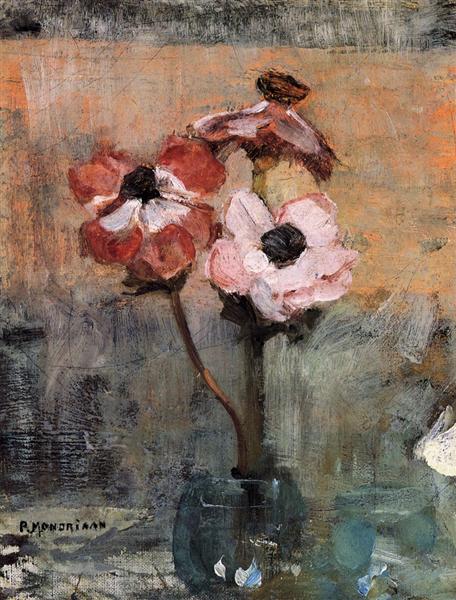Description
The work "Anemones in a vase" (1909) by Piet Mondrian is a fascinating manifestation of the artistic development of one of the masters more influential of modern art. Throughout his career, Mondrian explored the relationship between shape and color, and this painting represents an important moment in his transition to more abstract and geometric styles. At first glance, the viewer is attracted by the vibrant representation of the anemones, which emerge in a vase almost lush. Mondrian, in this work, shows his ability to capture natural beauty and emotional expression through the simplification of shapes and the bold use of color.
The composition of the painting is both organic and structured. The flowers, mostly of a white color with pink nuances, stand out in a back of darker tones, which highlights its fragility and beauty. The edges of the vase, although soft, create a contrast with the visual pollution of the environment, suggesting a connection between the natural world and the pictorial space. The use of light in the work also deserves attention; The subtle shadows and the game between light and dark invite the viewer to contemplate the three -dimensionality of the object represented.
Color is one of the most powerful elements in "anemones in a vase." Mondrian uses a relatively restricted palette, allowing flowers to have a strong and effective impact. This approach is prefigured in the artist's subsequent works, where color will become a fundamental element in its search for the essentials in art. Through these colors, Mondrian could be communicating not only the aesthetic nature of flowers, but also the emotions and symbolism that often accompanies them.
It is interesting to note that, although Mondrian is better known for its evolution towards neoplasticism, with vertical and horizontal lines and a limited use of primary colors, "anemones in a vase" reminds us that their formation as an artist develops in a context in the That naturalist and emotional representation still plays a crucial role. This work can be considered a bridge between his past and the abstract future that awaited him.
No human characters are observed in the work; However, the focus on flowers speaks of an intimate interaction with the viewer, suggesting a moment of familiarity and almost personal contemplation. In this sense, the anemones become a vehicle for the expression of the emotional state and the artist's connection with his surroundings.
As part of the broader context of Mondrian's artistic production, "anemones in a vase" is located before his radical stylistic transformation, where he began to move away from the figurative towards the abstract and geometric, but already manifesting a silhouette of his future aesthetics. This work is a reminder of the color potential and the way to communicate something deeper, echoing its artistic philosophy that would later define its subsequent work.
In short, this work encapsulates a key moment in the evolution of Piet Mondrian, showing its ability to navigate between representationism and abstraction. Through "anemones in a vase", the viewer is facing a work that not only stands out for its beauty, but also invites you to reflect on what will come in the artistic trajectory of one of the pioneers of modern art.
KUADROS ©, a famous paint on your wall.
Hand-made oil painting reproductions, with the quality of professional artists and the distinctive seal of KUADROS ©.
Art reproduction service with satisfaction guarantee. If you are not completely satisfied with the replica of your painting, we refund your money 100%.

